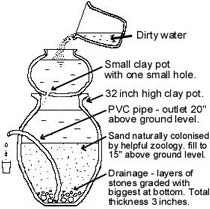Home-made biological filter: Construction
 The nadi (large clay pot) used for the filter must be 32 to 34 inches tall.
The nadi (large clay pot) used for the filter must be 32 to 34 inches tall.
A hole is made for the pipe in the side of the nadi using a screwdriver and a suitable stone or hammer. The bottom of the hole must be 20 inches above the ground.
A single piece of stiff flexible pipe 30 inches long, 1 inch in diameter, and with no splits in it, is fitted through the hole with one end inside the nadi, touching the bottom. It is put in place and the hole around the pipe is made water tight using cement.
A water storage pot for the filtered water must be chosen. If it is a nadi with a tap it should be put up high enough for a jug to go under its tap.
Put this clean water storage nadi on enough bricks to make this possible. The filter nadi can then be put in place on enough bricks for the protuding pipe to be just above the top of the storage nadi.
Potato size washed stones are placed in a single layer one stone deep at the bottom of the nadi. The gaps between them form channels for the water to flow easily into the pipe.
Small washed stones are placed on top filling the gaps between the potato size stones. Enough should be placed to prevent the next layer of gravel from falling through and blocking the gaps under the potato sized stones or clogging up the pipe.
A thin layer of washed, dhal (bean) size gravel is then spread to form a level surface over the small stones.
A thin layer of washed, seed size gravel is then spread to form a level surface over the dhal size gravel.
These drainage layers must not exceed 4 inches in total thickness or there will not be enough room for the main material, the sand.
Washed sand is then added to a level 5 inches below the level where the pipe goes through the side of the nadi.
The mutca (water carrying clay pot) is taken and a single hole is drilled in it using a 3 or 4 inch nail with a right angle bend in it to form a handle. At first this is difficult work but after a few minutes the hole is made without the need to hit it through with a hammer.
Most screw drivers make holes that are too large, so a nail is better.
The hole should be on the bottom of the mutca about 4 inches to one side so as not to get blocked too frequently by debris settling in the mutca.
The mutca is then tied in place on top of the nadi with the hole in the mutca in line with the pipe coming out of the nadi.
A stone is wedged between the mutca and nadi so that the hole in the mutca can be seen and so that it is easy to notice if the hole becomes blocked.
String must be used to fix the mutca in place in order to protect the good microbes in the nadi from being disturbed by childrens’ hands or other mis-use.
A cloth is tied over the mouth of the clean water storage nadi in such a way that the cloth is over the protruding pipe. The water should not be flowing onto the cloth at all, as this would re-contaminate the clean water.
The mutca can also be covered in thin cloth to screen out debris.
Downloads from the Lower Sindh Regional Development Association (LSRDA):
Download LSRDA_Teacher Training_Manual [PDF]
Download answer form for teacher training [JPG]
Download instruction poster [JPG]
Important note:
This clay pot filter design is meant for educating families who need to make their own filters and is not to be used for manufacturing, distribution or marketing of filters.
Clay pot filters are too heavy and fragile for distribution, though the materials a family needs to make one can easily be transported.
In projects where families don’t make their own, the advantage of the clay pot filter design is lost and it should not even be considered.
For these projects see the excellent work of CAWST and Davnor Water Treatment Technologies Ltd who hold international patent coverage and the best design for manufactured Bio-sand filters.
Note: You can download all of the manuals and files associated with this website on our download page